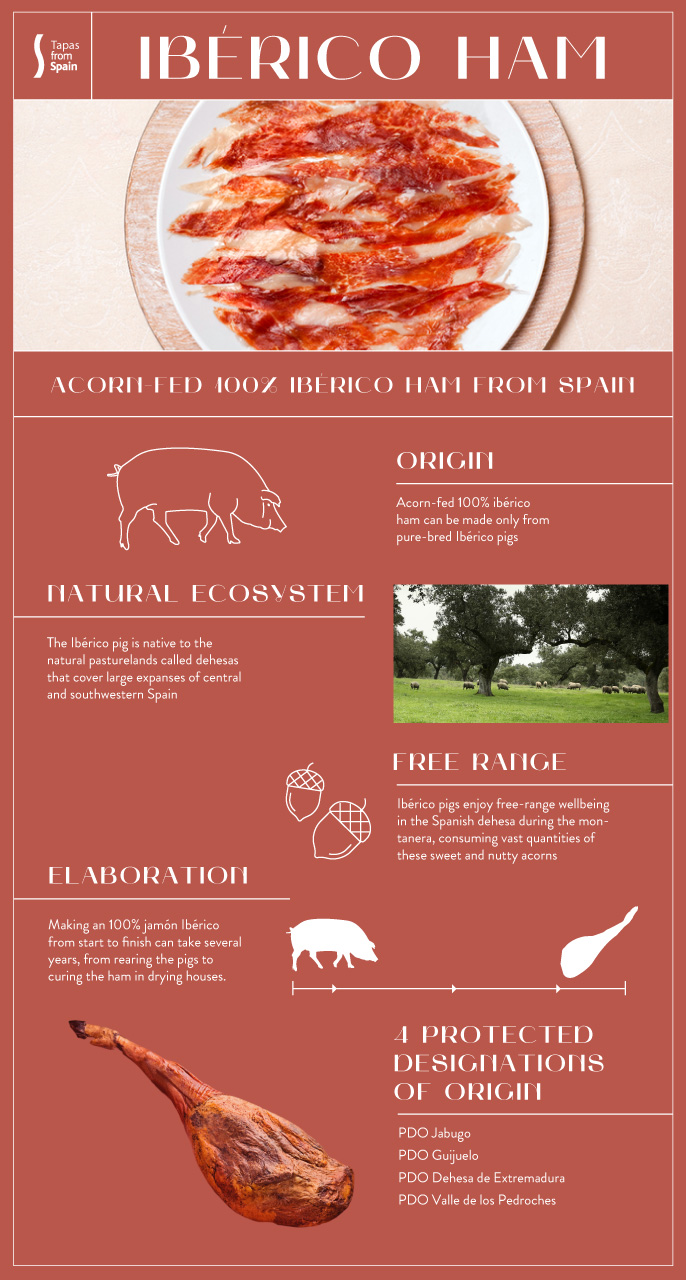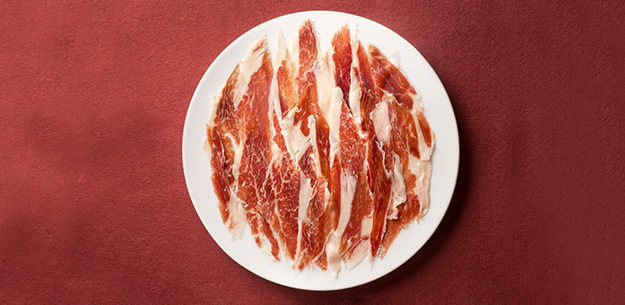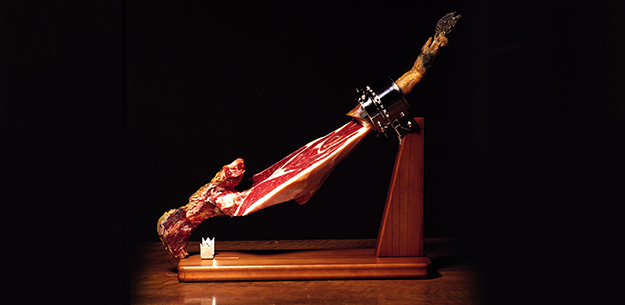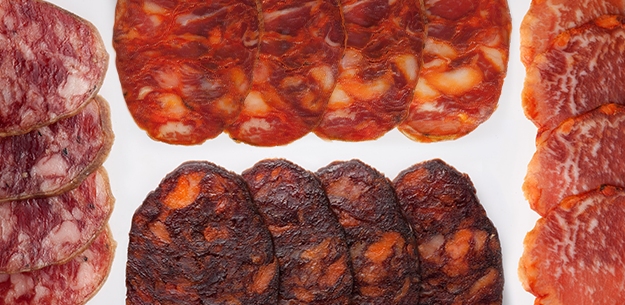.png.transform/rendition-xs/image_image%20(1).png)
Ibérico ham & pork
Acorn-fed Ibérico ham is considered a gourmet food, one that conquers the taste buds of anyone trying it for first time. It should be eaten in wafer-thin slices to appreciate the fragrant, delicate flesh, flecked with fat from the pigs’ acorn diet. Rich in monounsaturated fatty acids, the fat melts in the mouth, flooding the palate with its intense, long flavor.
Ibérico pigs
Pigs have always enjoyed a place of pride in Spanish gastronomy, and especially the singularly exceptional native breed the Ibérico pig. The Ibérico pig is the last of the grazing species in Europe. Its natural environment, the dehesa, the breeding method which allows the pigs to roam freely, and the artisan methods for preparing the pork products are relics of ancient traditions.
The Ibérico pig descends from a breed of wild boar that once roamed the Mediterranean basin. Its characteristics stem from its adaptation to the natural dehesa environment, from which it obtains its food. The word dehesa refers to the sparsely wooded pasturelands of holm and cork oaks that span large areas of central and south-western Spain in the provinces of Salamanca (Castile-León), Cáceres and Badajoz (Extremadura), Huelva and Córdoba (Andalusia), and Toledo and Ciudad Real (Castile-La Mancha). The dehesa is a complex, well-balanced ecosystem used for grazing pigs, cattle and sheep, as well as for grain cultivation, cork production and hunting. The preservation of this unique ecosystem is vital to preventing erosion and preserving the landscape, fauna and flora in a territory that cover about 2,300,000 hectares (5,683 million acres).
The characteristics of the Ibérico pig, with its long legs and strong, pointed snout, and its dark skin and hoofs are the result of its perfect integration into its environment. The pigs graze on everything offered by the dehesa – from grass and stubble to wild legumes – but, above all, they feast on acorns, which are the high-fat fruits of the holm and cork oaks.
This balanced, natural food is largely the reason for the excellent organoleptic qualities of the pork. These animals are able to store fatty deposits infiltrated in their muscles, making the meat especially moist and tender.
The production cycle of these pigs is longer than that of white pigs, and as a breed they are less prolific. For these reasons, together with the fact that the Ibérico pig produces less food than other pig breeds, the Ibérico pig headcount is low. In spite of the excellent quality of Ibérico pork meat and pork products, Ibérico pigs still account for a relatively small proportion of the total pig population in Spain.
While searching for acorns on the dehesa towards the end of the production cycle, the pigs are constantly exercising, and this exercise, along with the infiltrated fat, gives the meat its moistness and firm texture. The period during which the pigs graze freely towards the end of the summer and early autumn is known as the montanera. Pigs that gain at least fifty percent of their initial weight during the montanera are described as acorn-fed (de bellota,). Those that receive mixed feed are referred to as recebo. If they eat only grain, they are described as cebo, and if this is supplied in the open air, as cebo de campo. Finally, the labels on Ibérico hams, shoulders and loin sausages must state whether the product is pure Ibérico (when both parents were pure Ibérico pigs) or just Ibérico (at least 50% is of the Ibérico breed).
Ibérico ham
On the day of the annual matanza or pig slaughter, families living in the dehesa woodland areas of Spain were able to stock up with meat and pork products for the rest of the year. The Ibérico producers maintain this tradition, producing a wide range of cured meats and sausages from the succulent, aromatic meat of the Ibérico pig.
The best cuts of the Ibérico pig – the rear limbs (for hams) and the front limbs (for shoulders) – are used to make what are unanimously considered the world’s best hams. Many hams and shoulders are still made using traditional techniques in natural drying chambers at altitudes of over 600 meters (1,969 feet) above sea level. The names of towns like Guijuelo (Salamanca, Castile-León), Montánchez (Cáceres, Extremadura), Jabugo and Aracena (Huelva, Andalusia) will always be associated with ham and other Ibérico products.
The production process lasts almost two years, involving salting, settling, drying and curing. Although modern innovations have made it possible to reproduce optimum production conditions, the skill, experience and care of the artisan producers are still essential. The minimum curing period for an Ibérico ham is about 18 months, but it may exceed 24 months for larger hams.
Acorn-fed Ibérico ham is considered a gourmet food, one that conquers the taste buds of anyone trying it for first time. It should be eaten in wafer-thin slices to appreciate the fragrant, delicate flesh, flecked with fat from the pigs’ acorn diet. Rich in monounsaturated fatty acids, the fat melts in the mouth, flooding the palate with its intense, long flavor.
Charcuterie
Whole loin sausages (lomo) are made by dressing the meat with salt, pimentón (a kind of Spanish paprika), garlic, oregano and other seasonings. It is then stuffed into a natural casing and cured for at least four months. The Ibérico chorizos are famed for their exquisite aromas, made by seasoning lean meat with garlic, pimentón and other seasonings, following one of the many traditional recipes. Other products are Ibérico salchichón (made in a similar way to chorizo but with more spices and no pimentón), morcilla (blood sausage) and morcón (a coarsely-minced sausage made from lean pork with salt, garlic, sweet pimentón and pepper).
Fresh meat
Ibérico meat is also excellent fresh. Until recently, it was only available in pig-farming areas, but today it figures on the menus of leading chefs in Spain and elsewhere, especially in Japan. The preferred cuts of Ibérico pork include the solomillo (tenderloin), presa (shoulder loin), pluma (top loin), sorpresa (surprise), secreto (fore loin) and, more recently, carilleras (cheeks).
All in all, Ibérico pork can be considered one of the main contributions made by Spanish culinary culture to the world's gastronomic heritage.

Pigs have always enjoyed a place of pride in Spanish gastronomy, and especially the singularly exceptional native breed the Ibérico pig. The Ibérico pig is the last of the grazing species in Europe.
Santiago Botas/@ICEX. Edited by Adrienne Smith/@ICEX



- /content/dam/en/icex-foodswines/images/products/ibérico-ham---pork/Ibérico%20ham%20pork%20carr1.png
- /content/dam/en/icex-foodswines/images/products/ibérico-ham---pork/Ibérico%20ham%20pork%20carr2.png
- /content/dam/en/icex-foodswines/images/products/ibérico-ham---pork/Ibérico%20ham%20pork%20carr3.png

